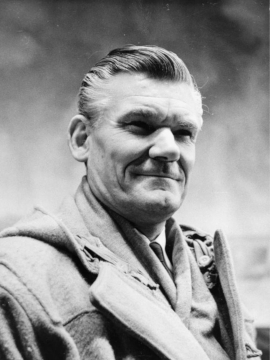Fred Copeman facts for kids
Quick facts for kids
Fred Copeman
|
|
|---|---|
 |
|
| Born | 1907 Beccles, Suffolk, England |
| Died | 1983 (aged 75–76) London, England |
| Allegiance | |
| Service/ |
|
| Years of service | 1921 – 1931 (Royal Navy) 1936 – 1939 (International Brigades) |
| Rank | Able Seaman Commandante |
| Commands held | British Battalion |
| Battles/wars | Spanish Civil War |
| Awards | Officer of the Order of the British Empire |
Frederick Bayes Copeman (1907–1983) was an English volunteer who fought in the International Brigades during the Spanish Civil War. He even commanded the British Battalion. He is also known for helping to organize London's air raid defenses during World War II.
Contents
Early Life and Training
Childhood in Beccles
Fred Copeman was born in 1907 in a workhouse near Beccles in East Suffolk, England. He lived there with his mother and brother, George. When Fred was nine, he and George moved to a Children's Home in Beccles. There, Fred made friends with a stray dog he named "Bonnie." Sadly, George was later sent to Canada by a children's charity, and Fred never saw him again.
When Fred was 12, he was sent to Watts Naval School in North Elmham, Norfolk. This school prepared boys for a life at sea. After two years, he joined the Royal Navy. He went to HMS Ganges, a training base in Suffolk. HMS Ganges was known for its tough training methods, which helped turn boys into skilled sailors.
From HMS Ganges, Fred was sent to the Mediterranean Fleet, based in Malta. He was very affected by the poverty he saw there. While in Malta, he learned to box and earned money as a heavyweight prizefighter. He also got into some trouble, spending three weeks in prison for a prank that went wrong.
The Invergordon Mutiny
Pay Cuts and Protests
In September 1931, the British government decided to cut public spending to deal with the Great Depression. This included a 10% pay cut for public workers, including the Navy. However, the cuts were not fair to everyone. Sailors of the Atlantic Fleet found out about the cuts from newspapers when they arrived at Invergordon in Scotland.
Fred Copeman, who was 24 and an able seaman on HMS Norfolk, explained that lower ranks would lose much more pay than senior officers. For example, an able seaman would lose 23% of their pay, while an admiral would lose only 7%.
A Peaceful Protest
The sailors were very upset by these unfair cuts. The protest, known as the Invergordon Mutiny, lasted for two days (September 15–16, 1931). Fred Copeman became part of the Norfolk's strike committee. The mutiny was completely peaceful. Even so, the Royal Navy punished many of the leaders and dismissed hundreds of sailors, including Fred Copeman.
Fred's Political Awakening
Fred Copeman later said that the mutiny was a turning point for him. He began to understand leadership and politics. Even though the sailors didn't see the mutiny as a political act, it changed his views. He realized the power that came from many people working together. Soon after, he joined the Communist Party and became very involved in political activism.
Union Activist and Imprisonment
After being discharged from the Royal Navy, Fred Copeman joined the National Unemployed Workers' Movement. He helped organize protests and demonstrations for unemployed people.
He was arrested several times for breaking rules against marches. In 1933, he was sent to Wandsworth Prison for two months. After being released, he was arrested again for the same reason and spent three more months in Brixton Prison. A few months later, he was arrested once more and spent four months in Wormwood Scrubs.
Fighting in the Spanish Civil War
Joining the International Brigades
Like many other members of the Communist Party, Fred Copeman decided to go to Spain to help defend the Second Spanish Republic. He left in November 1936 and joined the British Battalion of the International Brigades. These brigades were made up of volunteers from different countries who came to fight against fascism in Spain.
Wounded in Battle
At the Battle of Jarama in February 1937, Fred Copeman was wounded in his arm and head. He was known for being very strong and brave. Despite his injuries, he tried to keep leading his fellow soldiers. He was eventually taken away for treatment.
He seemed to recover fully and later became the commander of the battalion. However, just before another battle, the Battle of Teruel, he became very ill from an infection related to his old wound. He had to return home permanently.
Life After the War
Marriage and New Beliefs
After returning to England in 1938, Fred Copeman got married in Lewisham. About 1,100 people came to his wedding reception!
However, his experiences in Spain had changed him. He became unhappy with what he had seen and with the Communist Party. He later left the party. He also changed his beliefs, joining a movement called Moral Rearmament and then the Catholic Church.
Serving in World War II
The British Security Service MI5 watched Fred Copeman closely for many years. One officer described him as "one of these fiery people, who will shout about everything."
Despite this, when Second World War began, Fred played an important role in organizing civilian protection against German air raids in London. He used his experiences from Spain to argue that the government should make it mandatory for children to be evacuated from cities during the bombings. He believed it would save lives.
During the war, Fred managed the deep tube shelters, which were underground stations used as bomb shelters. He even gave lectures to the Royal Family at Buckingham Palace about this work. For his service, he was awarded the Officer of the Order of the British Empire (OBE) in 1946.
Later Political Life
Fred Copeman remained active in politics, though he became less extreme over time. He became a popular trade union organizer and a Labour Party councillor on Lewisham Borough Council. He tried to become a Member of Parliament in 1950 but was not successful.
Fred and his wife, Kitty, had four children. He passed away in London in 1983.
Works
- Reason in Revolt. London: Blandford Press, London, 1948. —autobiography


